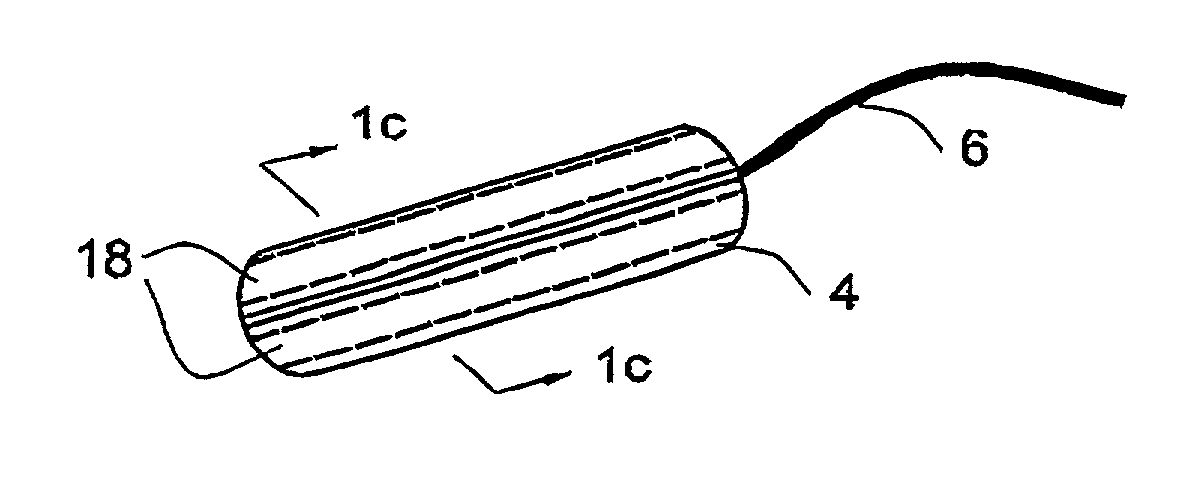System for transvaginal drug delivery
a technology of transvaginal drug and system, applied in the field of system and method of transvaginal drug delivery, can solve the problems of serious adverse effects such as bleeding, ulceration and perforation, and adverse renal effects, and achieve the effects of improving the safety and reducing the risk of bleeding, and improving the safety of women's health
- Summary
- Abstract
- Description
- Claims
- Application Information
AI Technical Summary
Benefits of technology
Problems solved by technology
Method used
Image
Examples
example 1
[0060]Tampons which undergo both radial and longitudinal expansion are generally manufactured for use with various types of applicator devices. The longitudinal expansion is generally more than 10% of its unexpanded length. This type of tampon comprises an inner core of absorbent material, such as cellulose fibers and / or cotton fibers, enveloped by an outer layer of liquid-permeable material such as a non-woven polymer, as for example polypropylene, polyethylene, polyester, cellulose, cellulose derivatives, or any combination of the above. This type of tampon is referred to in this specification as a “folded-type” tampon.
[0061]A folded-type tampon according to one embodiment of the invention is illustrated in FIG. 1a, in which can be seen a tampon 2 in its flat form comprising a body 4 and a withdrawal cord 6. The body 4 of the tampon comprises an outer layer 8 enveloping an inner absorbent core 10. The outer layer is held to the inner core in ways well known in the art, such as sew...
example 2
[0064]In another embodiment, illustrated in FIG. 2a, three strips are positioned at spaced intervals between the outer layer 22 and the inner core 24 of the flat tampon 28, perpendicularly to the longitudinal axis of the flat body 26 of the tampon. In this embodiment, the strips are wound around the width of the body 26 and then excised at the lateral edges 30 of the body so that there are 3 strips 20 on the upper surface 32 of the body and 3 corresponding strips 34 on the underside of the body. The length of each of the strips is equal to the width of the flat tampon. Preferably, the strips are positioned closer to the front end 36 of the tampon, opposite the withdrawal cord 38, since this the end with which the menstrual fluid first comes into contact.
[0065]The folded tampon 40 is illustrated in FIG. 2b, in which can be seen the annular strips 20. FIG. 2c shows how the strips 20,34 appear near the outer surface of the tampon between the outer layer 22 and the inner core 24, as wel...
example 3
[0066]A typical tampon which undergoes primarily radial expansion (a–3c. As in the folded-type tampon described above, it comprises an inner core of absorbent material, as in Example 1, enveloped by an outer layer of liquid-permeable material, as in Example 1. The rolled-type tampon differs from the folded-type tampon, inter alia, in their dimensions as well as in the manner of forming of the tampon. These differences affect the placement of the strips.
[0067]As shown in FIG. 3a, the flat tampon 48 comprises an absorbent layer 50 on which is placed an outer layer 52. The absorbent layer 50 is in the form of an extended rectangular ribbon. The material of the outer layer 52 is generally heat sealed to the upper side of the absorbent layer near one of its ends 54, an extension 56 of the outer layer partly extending beyond the end 54 of the absorbent layer. The length of the extension 56 is substantially equivalent to the circumference of the tampon in its final, folded form.
[0068]Accor...
PUM
 Login to View More
Login to View More Abstract
Description
Claims
Application Information
 Login to View More
Login to View More - R&D
- Intellectual Property
- Life Sciences
- Materials
- Tech Scout
- Unparalleled Data Quality
- Higher Quality Content
- 60% Fewer Hallucinations
Browse by: Latest US Patents, China's latest patents, Technical Efficacy Thesaurus, Application Domain, Technology Topic, Popular Technical Reports.
© 2025 PatSnap. All rights reserved.Legal|Privacy policy|Modern Slavery Act Transparency Statement|Sitemap|About US| Contact US: help@patsnap.com



